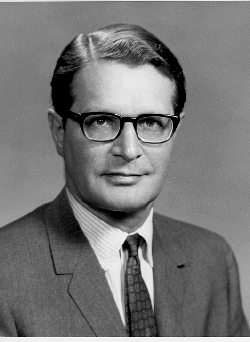Elliot Richardson (Elliot Lee Richardson)

Elliot Richardson had the distinction of serving in three high-level Executive Branch posts in a single year—the tumultuous year of 1973—as the Watergate Scandal came to dominate the attention of official Washington, and the American public at large. He served three relatively uneventful years as the Secretary of Health, Education, and Welfare for a popular sitting President. In September 1970, Richardson was present at the funeral of Gamal Abdel Nasser, President of Egypt as part of America’s delegation. He secretly met with Anwar Sadat, Nasser’s successor to discuss a possible peace process with the United States. Richardson was appointed United States Secretary of Defense on January 30, 1973. When President Nixon selected Richardson as Secretary, the press described him as an excellent manager and administrator, perhaps the best in the cabinet. In his confirmation hearing, Richardson expressed agreement with Nixon’s policies on such issues as the adequacy of U.S. strategic forces, NATO and relationships with other allies, and Vietnam. Although he promised to examine the budget carefully to identify areas for savings, and in fact later ordered the closing of some military installations, he cautioned against precipitate cuts. As he told a Senate committee, “Significant cuts in the Defense Budget now would seriously weaken the U.S. position on international negotiations—in which U.S. military capabilities, in both real and symbolic terms, are an important factor.” Similarly, he strongly supported continued military assistance at current levels. During his short tenure, Richardson spent much time testifying before congressional committees on the proposed FY 1974 budget and other Defense matters.
Elliot Richardson would serve as Secretary of Defense for 4 months before becoming Nixon’s Attorney General, a move that would put him in the Watergate spotlight. In October 1973, after Elliot Richardson had served 5 months as Attorney General, President Nixon ordered him to fire the top lawyer investigating the Watergate scandal, Special Prosecutor Archibald Cox. Richardson had promised Congress he would not interfere with the Special Prosecutor, and, rather than disobey the President or break his promise, he resigned. President Nixon subsequently ordered Richardson’s second-in-command, Deputy Attorney General William Ruckelshaus, to carry out the order. He too had promised not to interfere, and also tendered his resignation. The third in command, Solicitor General Robert Bork, planned to resign after firing Cox, but Richardson persuaded him not to in order to ensure proper leadership at the Department of Justice during the crisis. Bork carried out the President’s order, thus completing the events generally referred to as the Saturday Night Massacre. Just before the resignation of Vice President Spiro Agnew, Richardson was portrayed as a cartoon figure with Agnew and Nixon on the cover of Time Magazine dated October 8, 1973. Agnew was quoted as saying: “I am innocent of the charges against me. I will not resign if indicted!” Agnew later claimed the prosecution which eventually drove him from office was pushed by Richardson for the specific reason that Richardson wished to be nominated as the next Vice President, which would either give him the inside track for the Republican presidential nomination in 1976, or, should Nixon resign over Watergate, elevate Richardson to the presidency. Richardson denied both then and later taking any extraordinary steps in the investigation of Agnew, instead leaving the task up to the United States Attorney for the District of Maryland.
In 1974, Elliot Richardson received the John Heinz Award for Greatest Public Service by an Elected or Appointed Official, an award given out annually by Jefferson Awards. During the Gerald Ford administration, Richardson served as Ambassador to the United Kingdom from 1975–76 and as United States Secretary of Commerce from 1976–77. Richardson’s acceptance in 1975 of the appointment as Ambassador to the Court of St. James, as it is formally titled, effectively eliminated him from the domestic scene during the pre-election period. In departing for that position, he indicated to reporters that he would not run unless Ford decided against running. From 1977 to 1980, he served as an Ambassador at Large and Special Representative of President Jimmy Carter for the United Nations Convention on the Law of the Sea and head of the U.S. delegation to the Third United Nations Conference on the Law of the Sea. On New Year’s Eve, 1999, Elliot Richardson died of a cerebral hemorrhage in Boston, Massachusetts, at the age of 79. Major media outlets, such as CNN, recognized him as the “Watergate martyr” for refusing an order from President Nixon to fire special prosecutor Archibald Cox.
Born
- July, 20, 1920
- USA
- Boston, Massachusetts
Died
- December, 31, 1999
- USA
- Boston, Massachusetts
Cause of Death
- cerebral hemorrhage
Cemetery
- Arlington National Cemetery
- Arlington, Virginia
- USA



